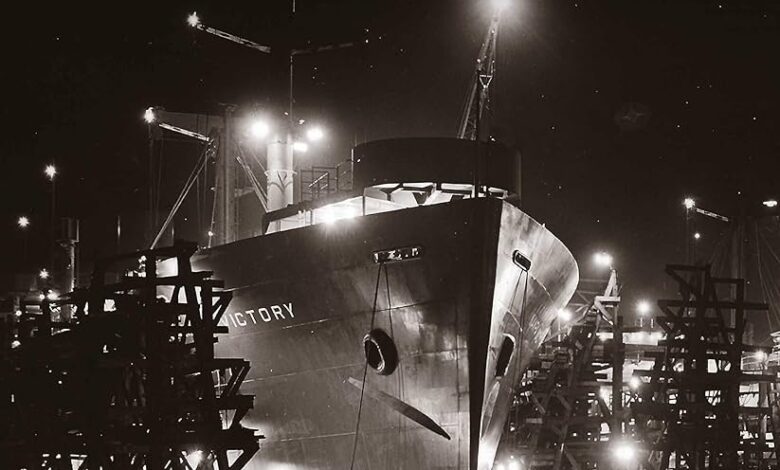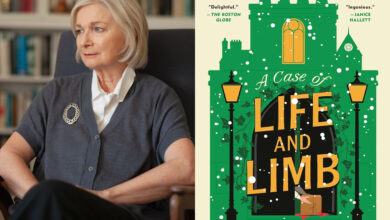Everyday People: Local author Peter Marsh writes book on Oregon’s WWII legacy

The Astoria-based sailor and writer holds book talk in Seaside Nov. 8
Former teacher, sailboater and boat builder, newspaper and mariner reporter, current director of the Hanthorn Cannery Museum and author, Peter Marsh never meant to stay in Oregon. But when he first arrived more than half a century ago, something about the gray light on the river and smell of salt in the air reminded him of home.
Marsh will discuss “Liberty Factory: The Untold Story of Henry Kaiser’s Oregon Shipyard” — and his lifelong connection to the sea — during a free talk from 2 to 3 p.m., Saturday, Nov. 8, at the Seaside Public Library, 1131 Broadway. A Q&A with the author will follow.
A homecoming of sorts
Marsh was enamored when he first set eyes on Oregon in 1972.
“I was captivated right away by Oregon’s maritime spirit,” Marsh said. “It felt familiar, and it still does.”
That scene has guided Marsh’s life and work ever since. Today, he directs the Hanthorn Cannery Museum at Pier 39, which takes up a corner spot in the old fishing cannery. The building sits at the end of a weathered wooden pier where seagulls cry and the tide laps below, a place that feels like it’s perpetually halfway between present and past.
When Marsh isn’t helping visitors navigate the cannery’s maze of historic artifacts, he’s often writing about the region’s seafaring past. His new book, “Liberty Factory: The Untold Story of Henry Kaiser’s Oregon Shipyard,” unearths the little-known story of industrialist Henry Kaiser. Kaiser, despite having no shipbuilding experience, transformed Portland, Swan Island and Vancouver, Washington, into some of the most productive shipyards during World War II.
Kaiser’s innovations in mass production, inspired by the automotive industry, allowed his workers to build Liberty ships at unprecedented speed, redefining Oregon’s wartime identity, Marsh said.
“Having spent 20 years writing as a marine journalist, I felt I could apply that experience to creating a three-dimensional story,” Marsh said. “A story in real space, with physical objects. I could make history come alive.”
Peter Marsh on Pier 39 holding his newest book, “Liberty Factory: The Untold Story of Henry Kaiser’s Oregon Shipyard.” (Courtesy of Peter Marsh)
That idea shaped not only the book, but also the way Marsh curates the Hanthorn Cannery Museum. Each exhibit, he says, is a kind of storytelling, “a story you can walk through.”
Marsh’s approach to writing carries the precision of a reporter and a reflection of his four decades as a freelance journalist covering nautical news along the Columbia River and across the Pacific Northwest.
“People have said the book reads like a series of articles,” Marsh said with a laugh. “You can close it at the end of a chapter and go to sleep. … I guess that’s just how I write, each section tells its own story.”
His path to the page was anything but traditional. Growing up in postwar Britain, Marsh had planned to become a physical education teacher — not a writer. But he also grew up in Greenwich, the birthplace of global navigation, where the Prime Meridian cuts the world in half.
“As a boy, I’d walk down and stand on the line at zero degrees,” he said. “You imagine how that line goes around the world. I’m proud of that connection, and if people don’t know it, they’re ignorant,” he added, laughing.
Those early walks sparked a lifelong fascination with geography, movement and discovery, threads that run through everything Marsh has done since.
He first came to Oregon in the 1970s and soon made Astoria his home. A lifelong sailor and designer, Marsh built his own 20-foot micro cruiser and began exploring the Columbia River in 1981. His voyages have taken him from Olympia to Glacier Bay — twice — across Lake Superior, and down the rugged Oregon Coast.
“When you’re under sail, the story of a place unfolds slowly,” he said. “You learn to see history in the landscape.”
In 2016, he set out on another kind of voyage, a cross-country bike trip that took him from Yorktown, Virginia, to Astoria along the 4,200-mile TransAmerica Bicycle Trail. He rode it over three summers, from 2016 to 2018, traveling roughly a thousand miles in a days- long stretch.
“I’d stop in small-town museums on the way,” he said. “On the Kansas prairie, in Wyoming, wherever I could. I’m kind of addicted to museums. There’s always something to learn.”
Those cross-country stops mirrored his own mission back home: preserving local stories before they disappear.
While living in Portland, Marsh befriended the late Larry Barber, the longtime maritime editor of The Oregonian. After Barber’s death in 1997, Marsh inherited his vast archive of photos, clippings and notes, a treasure trove of maritime history.
“At first, I didn’t realize what I had,” Marsh said. “But slowly it became evident that the diaries and pictures recorded in unique detail largely overlooked the story of Oregon’s massive contributions to the WWII shipbuilding effort.”
For the past five years and 10 months, Marsh has been sorting, editing and researching that material, a painstaking effort that became the backbone of “Liberty Factory.” The work, he says, felt like rediscovering Oregon through Barber’s eyes.
Beyond Oregon
His fascination with history extends far beyond Oregon. During a cycling trip through France in 2019, Marsh found himself pedaling along the beaches of Normandy, the same D-Day shores that defined a generation.
“It was an intensely emotional experience,” he said quietly. “For anyone who grew up in postwar Britain, it stays with you.”
That moment, of stumbling into history without expecting it, is something he hopes visitors to the Hanthorn Cannery Museum experience, too.
“I want people to discover history here when they’re not expecting it,” he said. “That’s the magic.”
Once a writer, always a writer
Marsh still writes most days, often sketching out ideas by hand before typing them up. “I like to make discoveries while I’m writing,” he said. “I like to surprise myself.”
Asked what his biggest discovery was while working on “Liberty Factory,” he paused for a long moment, then smiled.
“That I could actually do it,” he said. “That I could sit down and create something new — chapter by chapter. You imagine it like building a ship: one piece at a time, until it finally floats.”
Source link




